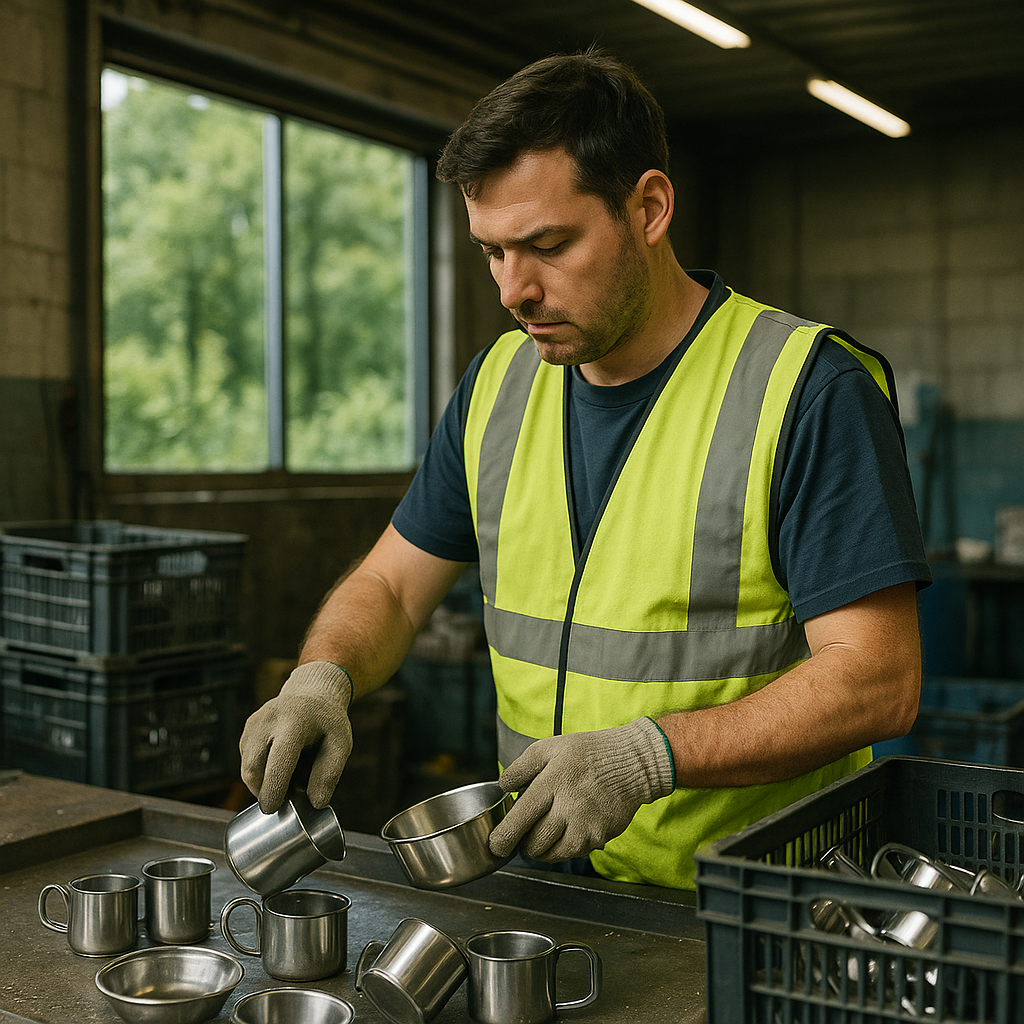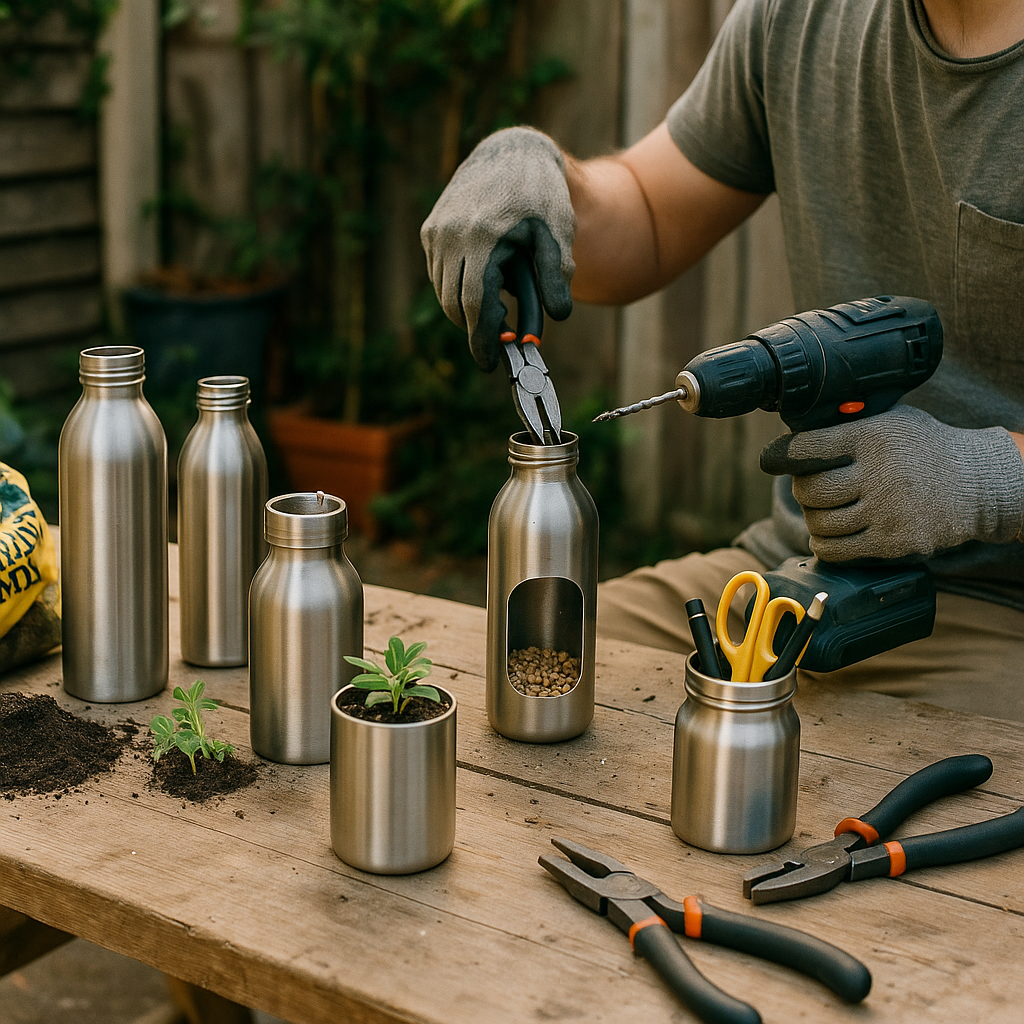5901 Botham Jean Blvd, Dallas, TX 75215
Can You Recycle Stainless Steel Water Bottles?
May 14, 2025Yes, stainless steel water bottles are highly recyclable. This durable material can be processed and repurposed almost indefinitely without losing its quality or strength. Most recycling centers and scrap metal yards readily accept stainless steel bottles for processing.
The sustainability benefits of recycling these bottles go beyond reducing waste. Recycled stainless steel requires significantly less energy to process compared to mining and refining raw materials. This energy efficiency directly translates to lower carbon emissions throughout the manufacturing chain.
The economic value of recycling stainless steel is substantial. The process reduces reliance on raw material mining, cuts manufacturing costs, and conserves natural resources. As commodity prices for metals fluctuate, the recycling industry provides a stable, domestic source of valuable materials that support local economies and create jobs in the circular economy sector.
How Do You Prepare Stainless Steel Water Bottles for Recycling?
Preparing your stainless steel water bottle for recycling involves a few essential steps. Proper preparation ensures the recycling process is efficient and environmentally friendly.
Begin by cleaning the bottle thoroughly with warm water and mild detergent. Use a bottle brush to scrub the interior and remove any residue or buildup. Rinse well to ensure no soap remains inside.
Next, disassemble the bottle by removing all non-metal components, such as plastic caps, rubber seals, silicone gaskets, and decorative elements. These parts typically need to be recycled separately or disposed of according to local guidelines.
Ensure the stainless steel portion is completely dry before recycling to prevent contamination. Some recycling facilities may reject items that are dirty or contain moisture.
Check whether your local curbside recycling program accepts stainless steel. Many municipal programs have specific guidelines for metal recycling. You can usually find this information on your local government website or by contacting your waste management provider.
If your curbside program doesn’t accept stainless steel, locate a nearby recycling center or scrap metal dealer that does. Resources like Earth911 or RecyclingCenters.org can help you find facilities in your area that accept metal items.
Remember, stainless steel is 100% recyclable and a valuable material in the recycling stream. By preparing your water bottle properly, you contribute to resource conservation and reduce the need for new raw materials.
For bottles in good condition that are no longer needed, consider donating them as an alternative to recycling. Many organizations welcome reusable water bottles, extending the product’s useful life.
| Step | Description |
| 1 | Clean the bottle thoroughly with warm water and mild detergent. Use a bottle brush to remove residue. |
| 2 | Rinse well to ensure no soap remains inside the bottle. |
| 3 | Disassemble the bottle by removing all non-metal components such as plastic caps, rubber seals, and silicone gaskets. |
| 4 | Ensure the stainless steel portion is completely dry before recycling to prevent contamination. |
| 5 | Check local recycling guidelines to see if your curbside program accepts stainless steel. If not, find a nearby recycling center or scrap metal dealer. |
What Are the Environmental Benefits of Recycling Stainless Steel Bottles?

Recycling stainless steel bottles reduces the demand for raw materials. Producing stainless steel with 85% recycled content generates only 1.45 tonnes of CO2 per ton, a 50% reduction compared to using virgin materials. This decrease helps minimize the carbon footprint associated with mining and manufacturing new steel.
The energy savings from stainless steel recycling are substantial. Recycling these bottles can save up to 33% of the energy required for primary production, leading to lower greenhouse gas emissions and a more sustainable energy profile across the industry. The World Stainless Association confirms these efficiency gains are driving significant environmental improvements.
Natural resource conservation is another critical benefit. Mining operations for chromium, nickel, and other alloying elements used in stainless steel production often lead to habitat destruction, water pollution, and soil degradation. By recycling existing bottles, we reduce the need for extracting these finite resources and minimize environmental damage at mining sites.
Landfill waste reduction cannot be overlooked. Stainless steel bottles that end up in landfills can take hundreds of years to decompose. By diverting these items through recycling programs, we prevent long-term pollution while creating a valuable stream of materials that can be used indefinitely without degradation.
The circular economy benefits are particularly impressive with stainless steel. Unlike many materials that lose quality during recycling, stainless steel maintains its essential properties through unlimited recycling cycles. This makes it ideal for sustainable manufacturing systems where resources are continuously reused rather than discarded.
Some European stainless steel plants have achieved recycled content levels as high as 94.6%, demonstrating the enormous potential for this material in circular production models. Companies like Outokumpu have reported 20% reductions in their carbon footprints by focusing on recycling and energy efficiency improvements.
Water conservation is another significant advantage. Virgin stainless steel production requires substantial water resources for processing and cooling. Recycling drastically reduces these water demands, helping preserve this vital resource, especially in regions experiencing water stress or scarcity.
Zero waste initiatives gain substantial support through stainless steel recycling. These bottles can be completely recycled without generating additional waste streams, supporting municipalities and organizations committed to eliminating landfill contributions. This closed-loop approach represents the gold standard in sustainable materials management.
Are There Creative Ways to Repurpose Old Stainless Steel Water Bottles?

Stainless steel water bottles are known for their durability, but even they can show wear over time. Instead of discarding them, try repurposing them creatively. These sustainable projects not only reduce waste but also add unique decorative and functional elements to your home.
Transform Bottles into Decorative Planters
One popular idea is turning old stainless steel bottles into planters. The metal’s durability makes it perfect for small plants, herbs, or succulents. Clean the bottle thoroughly, cut the top if needed, and add drainage holes at the bottom.
For herb gardens, wider-mouthed bottles work well. Fill with potting soil, add herb seeds, and place on a sunny windowsill. The metallic finish adds an industrial chic look to any kitchen while providing fresh herbs for cooking.
Enhance the visual appeal by painting the exterior or wrapping it with materials like twine or rope, creating texture and transforming the bottle into a stylish container that complements your decor.
Create Functional Storage Solutions
Stainless steel bottles are excellent for storing various household items. Their durability and leak-proof design make them ideal for organizing small items.
In the kitchen, repurpose bottles as canisters for dry goods like tea, coffee, or spices. The airtight seals keep contents fresh longer than conventional options. Label them with chalk if they have a brushed finish or add decorative tags for easy identification.
In creative spaces, these bottles are perfect as brush holders, pencil cups, or containers for art supplies. Their sturdy construction prevents tipping, while their sleek appearance adds organization to your workspace.
Craft Unique Outdoor Accessories
The weather-resistant properties of stainless steel make these bottles perfect for outdoor projects. With creativity, you can transform them into functional garden accessories.
Create a bird feeder by cutting openings in the bottle and adding perches with wooden dowels. The metallic surface reflects sunlight, attracting birds while providing nourishment.
For evening ambiance, convert bottles into lanterns. Cut decorative patterns into the sides and place a candle inside. The metal’s reflective quality amplifies the light, creating beautiful shadow patterns.
Another option is using them as watering cans for seedlings. Drill small holes in the cap to create a gentle shower effect that won’t disturb young plants.
Design Decorative Home Accents
Stainless steel bottles can become striking decorative pieces that showcase creativity while adding unique elements to your home.
Turn bottles into elegant vases by cleaning them and adding fresh flowers. The metallic finish contrasts beautifully with colorful blooms, making them perfect centerpieces.
For a more elaborate project, create wind chimes by cutting bottles into different lengths and suspending them from a central ring. The stainless steel produces clear, resonant tones that add a peaceful soundtrack to your space.
Practical Kitchen Tools
The smooth surface and cylindrical shape of stainless steel bottles make them versatile for kitchen applications beyond storage.
Use a clean bottle as a rolling pin for baking. The stainless steel can be chilled beforehand, making it excellent for temperature-sensitive doughs like pastry that benefit from staying cool.
Convert bottles into shakers for salad dressings or marinades. The secure caps allow for vigorous shaking to blend ingredients thoroughly without leaking. The narrow opening provides controlled pouring when serving.
For homemade stocks or broths, stainless steel bottles offer excellent storage. Their airtight seals preserve freshness while the metal ensures no unwanted flavors are absorbed into your creations.
Conclusion: Embracing Sustainable Practices with Stainless Steel Bottles
![]()
Recycling stainless steel water bottles is a simple yet effective way to promote environmental sustainability. These durable containers provide significant environmental advantages throughout their lifecycle. When recycled correctly, stainless steel bottles reduce reliance on single-use plastics, conserve resources, and decrease landfill waste.
The journey toward sustainability involves both individual and collective efforts. By choosing reusable stainless steel bottles and ensuring they are recycled properly at the end of their life, we contribute to a circular economy where materials retain their value and continue to serve purposes rather than becoming waste. This approach conserves energy, reduces greenhouse gas emissions, and safeguards our natural resources for future generations.
Ready to enhance your recycling efforts? For professional recycling solutions that maximize environmental benefits, contact Okon Recycling at 214-717-4083.
